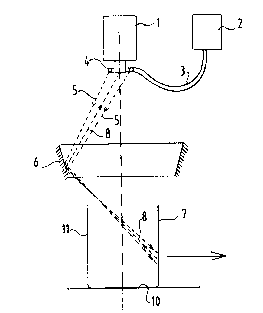Une partie des informations de ce site Web a été fournie par des sources externes. Le gouvernement du Canada n'assume aucune responsabilité concernant la précision, l'actualité ou la fiabilité des informations fournies par les sources externes. Les utilisateurs qui désirent employer cette information devraient consulter directement la source des informations. Le contenu fourni par les sources externes n'est pas assujetti aux exigences sur les langues officielles, la protection des renseignements personnels et l'accessibilité.
L'apparition de différences dans le texte et l'image des Revendications et de l'Abrégé dépend du moment auquel le document est publié. Les textes des Revendications et de l'Abrégé sont affichés :
| (12) Demande de brevet: | (11) CA 2002569 |
|---|---|
| (54) Titre français: | DISPOSITIF D'INSPECTION DE LA PAROI INTERNE D'UN CORPS |
| (54) Titre anglais: | DEVICE FOR INSPECTING THE INNER WALL OF A BODY |
| Statut: | Réputée abandonnée et au-delà du délai pour le rétablissement - en attente de la réponse à l’avis de communication rejetée |
| (51) Classification internationale des brevets (CIB): |
|
|---|---|
| (72) Inventeurs : |
|
| (73) Titulaires : |
|
| (71) Demandeurs : |
|
| (74) Agent: | SMART & BIGGAR LP |
| (74) Co-agent: | |
| (45) Délivré: | |
| (22) Date de dépôt: | 1989-11-09 |
| (41) Mise à la disponibilité du public: | 1990-05-28 |
| Licence disponible: | S.O. |
| Cédé au domaine public: | S.O. |
| (25) Langue des documents déposés: | Anglais |
| Traité de coopération en matière de brevets (PCT): | Non |
|---|
| (30) Données de priorité de la demande: | ||||||
|---|---|---|---|---|---|---|
|
ABSTRACT
The invention relates to the inspection of the
inside of a body, for example the inner surface of a metal
container such as a preserves can.
The best possible inspection is ensured with light-
ing from the same direction as that from which the inspection,
for example with a video camera, takes place. The invention
therefore provides a device for inspecting the inner surface
of a hollow body such as a metal container with a cylindrical
standing wall and a bottom, which device comprises:
positioning means for placing the body at a chosen
position;
a light source which is placed relative to the
positioning means such that it can light the said inner sur-
face at least approximately uniformly; and
an inspection means, for example a video camera,
which is placed relative to the positioning means such that
it can inspect the said inner surface,
whereby the direction of lighting and the direction
of inspection of each portion of the said inner surface at
least approximately coincide.
Note : Les revendications sont présentées dans la langue officielle dans laquelle elles ont été soumises.
Note : Les descriptions sont présentées dans la langue officielle dans laquelle elles ont été soumises.

2024-08-01 : Dans le cadre de la transition vers les Brevets de nouvelle génération (BNG), la base de données sur les brevets canadiens (BDBC) contient désormais un Historique d'événement plus détaillé, qui reproduit le Journal des événements de notre nouvelle solution interne.
Veuillez noter que les événements débutant par « Inactive : » se réfèrent à des événements qui ne sont plus utilisés dans notre nouvelle solution interne.
Pour une meilleure compréhension de l'état de la demande ou brevet qui figure sur cette page, la rubrique Mise en garde , et les descriptions de Brevet , Historique d'événement , Taxes périodiques et Historique des paiements devraient être consultées.
| Description | Date |
|---|---|
| Inactive : CIB de MCD | 2006-03-11 |
| Inactive : Abandon.-RE+surtaxe impayées-Corr envoyée | 1996-11-11 |
| Inactive : Demande ad hoc documentée | 1996-11-11 |
| Demande non rétablie avant l'échéance | 1993-05-09 |
| Le délai pour l'annulation est expiré | 1993-05-09 |
| Inactive : Demande ad hoc documentée | 1992-11-09 |
| Réputée abandonnée - omission de répondre à un avis sur les taxes pour le maintien en état | 1992-11-09 |
| Demande publiée (accessible au public) | 1990-05-28 |
| Date d'abandonnement | Raison | Date de rétablissement |
|---|---|---|
| 1992-11-09 |
Les titulaires actuels et antérieures au dossier sont affichés en ordre alphabétique.
| Titulaires actuels au dossier |
|---|
| HEUFT-QUALIPLUS B.V. |
| Titulaires antérieures au dossier |
|---|
| MARCELLINES J. J. OBDEIJN |